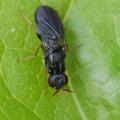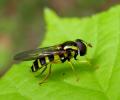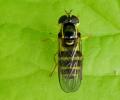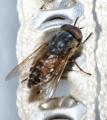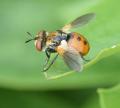|
Homoneura
|
|
| Nikita Vikhrev |
Posted on 10-01-2008 15:40
|
|
Member Location: Posts: 9193 Joined: 24.05.05 |
Whithout hope to get immediately species name, but to make winter less greyish  Thai, Khao Khitchakut, common species Nikita Vikhrev - Zool Museum of Moscow University |
|
|
|
| Paul Beuk |
Posted on 10-01-2008 15:48
|
|
Super Administrator Location: Posts: 19208 Joined: 11.05.04 |
I cannot see the wing margin close enough to say you are wrong, but in this part of the would this would be something like Pseudolyciella.  Still Homoneura is such a large genus in that part of the world, I guess we should not be surprised at anything. Still Homoneura is such a large genus in that part of the world, I guess we should not be surprised at anything.
Paul - - - - Paul Beuk on https://diptera.info |
|
|
|
| Nosferatumyia |
Posted on 10-01-2008 15:55
|
|
Member Location: Posts: 3396 Joined: 28.12.07 |
Nikita, it loox to have a pennate arista! It is a Curtonotum (Curtonotidae). Ask Ashley Kirk-Spriggs, perhaps he knows.
Edited by Nosferatumyia on 10-01-2008 16:12 Val |
|
|
|
| Nikita Vikhrev |
Posted on 10-01-2008 16:12
|
|
Member Location: Posts: 9193 Joined: 24.05.05 |
No, Valery, I know Curtonotidae (and Oriental Axinota), it isn't. Paul, costa looks for me as homoneuroid type, but of course, I do not insist. Species collected in enough amount and someday will get name... Nikita Vikhrev - Zool Museum of Moscow University |
|
|
|
| Nosferatumyia |
Posted on 10-01-2008 16:17
|
|
Member Location: Posts: 3396 Joined: 28.12.07 |
Nikita Vikhrev wrote: No, Valery, I know Curtonotidae (and Oriental Axinota), it isn't. Paul, costa looks for me as homoneuroid type, but of course, I do not insist. Species collected in enough amount and someday will get name... It ISN'T Axinota. It IS a Curtonotum. Doncha have any specimens in Moscow? I do have. And I have compared your pig w/ C. anus specimens. Everything, incl. eye shape, long pennate arista, body and leg coloration and bristling. Please trust me. Val |
|
|
|
| Nikita Vikhrev |
Posted on 10-01-2008 16:33
|
|
Member Location: Posts: 9193 Joined: 24.05.05 |
No, Valery, it is Lauxaniidae. I have specimen of C.anus, I know this fly, I collected it myself and observed it in South Turkey. Curtonotidae has very inmistakable type of flight (both Axinita and Curtonotum). It's flight looks as balerina moving - like tiptoe touching surface (or being ready to touch)
Nikita Vikhrev - Zool Museum of Moscow University |
|
|
|
| Nosferatumyia |
Posted on 10-01-2008 16:55
|
|
Member Location: Posts: 3396 Joined: 28.12.07 |
Nikita, ask Shatalkin, if he knows any lauxaniid genus w/ that large flat scutellum. Cheers,
Val |
|
|
|
| jorgemotalmeida |
Posted on 10-01-2008 17:28
|
|
Member Location: Posts: 9295 Joined: 05.06.06 |
to me - I might be wrong, though - this is Curtonotidae. -> arista plumose and long! -> 2 pairs of frontal bristles and proclinate (NONE curves backward as in Lauxaniidae -- referring to the Frontal bristles.. only one reclinat) -> I can see one oc bristle, at least (Lauxiniidae has it as well, but other features seems to point to another family) -> hunchbacked thorax -> all tibiae with dorsal pre-apical bristle (well visible in the female.)  -> bristle present in postpronotum (humeral callus!) -> general jizz It would help to see better the frontal head and the wing. I hope this can trigger more confusion. 
Edited by jorgemotalmeida on 10-01-2008 22:34 |
|
|
|
| Kahis |
Posted on 10-01-2008 17:44
|
|
Member Location: Posts: 1999 Joined: 02.09.04 |
I'd say Homoneura. There are many Palearctic species with such an arista especially in the southern parts of the estern half, for examply Homoneura unguiculata, known from Japan, China, Vietnam, Sri Lanka and elsewhere as a synanthrope. Nothing in this fly suggests Curtonotum in my opinion 
Edited by Kahis on 10-01-2008 17:46 Kahis |
|
|
|
| jorgemotalmeida |
Posted on 10-01-2008 17:48
|
|
Member Location: Posts: 9295 Joined: 05.06.06 |
Nikita Vikhrev wrote: No, Valery, it is Lauxaniidae. I have specimen of C.anus, I know this fly, I collected it myself and observed it in South Turkey. Curtonotidae has very inmistakable type of flight (both Axinita and Curtonotum). It's flight looks as balerina moving - like tiptoe touching surface (or being ready to touch) Make a video, Nikita!  I would like to see a fly "dancing" a ballerina. I would like to see a fly "dancing" a ballerina. In the another family.... as you know tabanids can do this - >  http://diptera.in...&pid=17677 |
|
|
|
| jorgemotalmeida |
Posted on 10-01-2008 17:51
|
|
Member Location: Posts: 9295 Joined: 05.06.06 |
Kahis wrote: I'd say Homoneura. There are many Palearctic species with such an arista especially in the southern parts of the estern half, for examply Homoneura unguiculata, known from Japan, China, Vietnam, Sri Lanka and elsewhere as a synanthrope. Nothing in this fly suggests Curtonotum in my opinion  Would the presence of the vibrissae discard the Homoneura? (I don't know any lauxaniid with vibrissae. If there one, let me know.) Unfortunately we cannot be sure if these flies have or not the vibrissae. However, wing venation is more reliable for this case, I think. Edited by jorgemotalmeida on 10-01-2008 17:56 |
|
|
|
| Steve Gaimari |
Posted on 10-01-2008 22:06
|
|
Member Location: Posts: 169 Joined: 08.10.04 |
Hi all, This is absolutely a lauxaniid - no doubt about it. The aristal condition is common in lauxaniids. The fronto-orbitals are both clearly reclinate (the proclinate seta is the ocellar). There are no vibrissa. Everything about it is typical. The species is Homoneura beckeri (Kertesz). I have compared it to the photographs I have of a male syntype from the collection in Budapest, and I have another 40 specimens on hand. It is rather widespread species - Taiwan, India (Madras), Indonesia (Java, Sumatra, Lombok), Krakatau, Nepal, Singapore, China, Thailand. Cheers, Steve  |
|
|
|
| jorgemotalmeida |
Posted on 10-01-2008 22:10
|
|
Member Location: Posts: 9295 Joined: 05.06.06 |
 I must learn so many things about lauxaniid yet .  Thanks for clarification, Steve. Edited by jorgemotalmeida on 10-01-2008 22:11 |
|
|
|
| jorgemotalmeida |
Posted on 10-01-2008 22:26
|
|
Member Location: Posts: 9295 Joined: 05.06.06 |
Steve Gaimari wrote: Hi all, This is absolutely a lauxaniid - no doubt about it. The aristal condition is common in lauxaniids. The fronto-orbitals are both clearly reclinate (the proclinate seta is the ocellar). There are no vibrissa. Everything about it is typical. The species is Homoneura beckeri (Kertesz). I have compared it to the photographs I have of a male syntype from the collection in Budapest, and I have another 40 specimens on hand. It is rather widespread species - Taiwan, India (Madras), Indonesia (Java, Sumatra, Lombok), Krakatau, Nepal, Singapore, China, Thailand. Cheers, Steve  I see one pair of proclinate frontal bristles, two pairs of reclinate frontal bristles and one pair of postocellar bristles. Right? Edited by jorgemotalmeida on 10-01-2008 22:32 |
|
|
|
| Nikita Vikhrev |
Posted on 10-01-2008 22:34
|
|
Member Location: Posts: 9193 Joined: 24.05.05 |
Some common Homoneura IDable by photo! Thank you Steve  Jorge - only 2 pairs of or (or =fronto-orbital), both reclinate, postocellar crossed (not visible at this photo, at least to me). Nikita Nikita Vikhrev - Zool Museum of Moscow University |
|
|
|
| jorgemotalmeida |
Posted on 10-01-2008 22:41
|
|
Member Location: Posts: 9295 Joined: 05.06.06 |
Nikita - I see one or proclinate too, or is it a crossed bristle? (see the male) Postocellar bristles seems to me reclinate, but the angle is not the best to be sure.  edit: not postocellar. they are not visible in the photo.  so forget my last statement. I overpassed your parenthesis! so forget my last statement. I overpassed your parenthesis! 
Edited by jorgemotalmeida on 10-01-2008 23:12 |
|
|
|
| Nikita Vikhrev |
Posted on 10-01-2008 22:48
|
|
Member Location: Posts: 9193 Joined: 24.05.05 |
proclinate bristles are ocellare, postocellare crossed = inclinate, male's left posterior fronto-or is broken, both right or are OK, also ivt and ovt are visible
Nikita Vikhrev - Zool Museum of Moscow University |
|
|
|
| jorgemotalmeida |
Posted on 10-01-2008 22:59
|
|
Member Location: Posts: 9295 Joined: 05.06.06 |
ok. got it! thanks, Nikita!  |
|
|
|
| Jump to Forum: |


